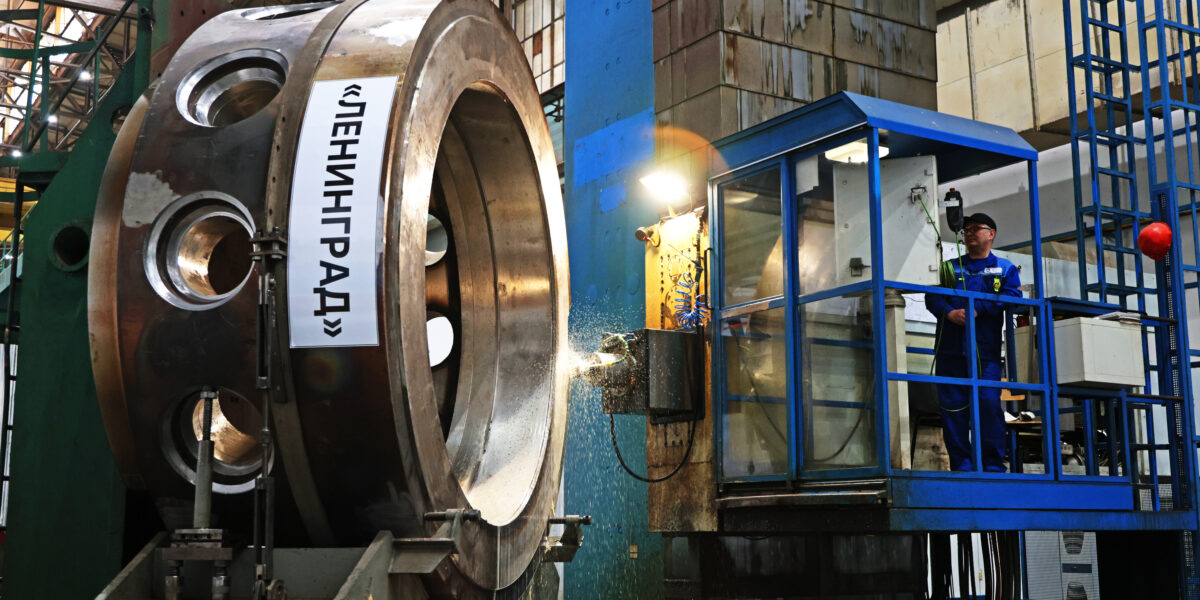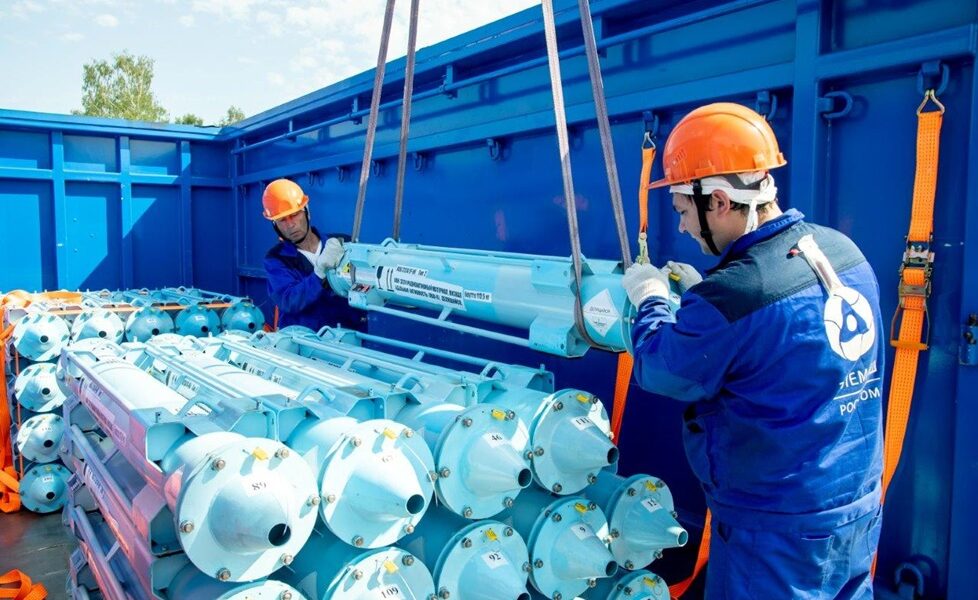On November 18, in St. Petersburg, President of Russia Vladimir Putin took part via videoconference in the keel-laying ceremony for the Project 22220 sixth serial-produced universal nuclear-powered icebreaker Stalingrad. The ceremony took place at the Baltic Shipyard JSC (St. Petersburg) on the eve of a significant date for our country: November 19, 1942, the Soviet counteroffensive began near Stalingrad, codenamed Operation Uranus, which changed history forever.
The ceremony was attended by Igor Rudenya, Plenipotentiary Representative of the President of the Russian Federation in the Northwestern Federal District; Anton Alikhanov, Minister of Industry and Trade (via video link); Andrey Bocharov, Governor of the Volgograd Region; Aleхey Likhachev, Director General of Rosatom; Andrey Puchkov, Chief Executive Officer of the United Shipbuilding Corporation JSC; Pavel Vinokurov, a veteran of the Great Patriotic War and participant in the Battle of Stalingrad; and others.
Vladimir Putin opened the solemn ceremony. The head of state addressed the audience via videoconference with a welcoming speech. “The tasks before us are, without exaggeration, historic. It is important to consistently strengthen Russia’s position in the Arctic, fully realize our country’s logistics potential, and ensure the development of a promising Trans-Arctic Transport Corridor from St. Petersburg to Vladivostok”, he said.
The head of Rosatom noted that in the year of the 80th anniversary of Victory Day and the Russian nuclear power industry, nuclear workers feel the connection between the times especially keenly. “The first Soviet atomic bomb deprived our enemies of the monopoly on nuclear weapons and ensured peace for decades. Today our atomic power is a tool for creation. A nuclear-powered icebreaker is a peaceful atom in the service of people and the state”, said Alexey Likhachev.
Andrei Bocharov spoke at the ceremony via videoconference, and Pavel Vinokurov presented a capsule containing soil from Mamayev Kurgan to Aleksey Likhachev. He noticed: “Let this powerful icebreaker, bearing the name of our greatest battle, pave the way through the ice as steadfastly and courageously as our soldiers marched to Victory. Steer the course! And remember – Russia is with you!”
The honorary right to place the fitting board on the first section of the sixth serial-produced universal nuclear-powered icebreaker Stalingrad was granted to Igor Rudenya, Alexey Likhachev, Pavel Vinokurov and Daniil Kononov, a participant in the Rosatom Arctic expedition Icebreaker of Knowledge (Ledokol Znanii).
The most important task for the near future is to ensure year-round navigation along the Trans-Arctic Transport Corridor and the Northern Sea Route. For this purpose, new nuclear-powered icebreakers are being built by order of Rosatom. At the Baltic Shipyard, construction of the Project 22220 icebreakers Chukotka and Leningrad continues, while the world's most powerful lead nuclear-powered icebreaker Rossiya of Project 10510 Lider is being built at the Zvezda shipyard in the Far East.
In 2024, a record was set for cargo flow via the NSR – 37.9 million tons (in 2023 – 36.25 million tons). The record for transit traffic in the Northern Sea Route waters was broken – 3.09 million tons (for comparison, in 2023 it was 2.127 million tons). Many foreign countries, including China, India, and the UAE, are showing interest in the NSR logistics artery. A significant increase in traffic is expected in the coming years: By 2035, transportation volumes are planned to reach 220 million tons per year. The introduction of new Project 22220 universal nuclear-powered icebreakers will contribute to achieving this goal. The lead nuclear-powered icebreaker, Rossiya, of Project 10510, will ensure smooth escort of vessels in the eastern part of the Northern Sea Route.
The nuclear-powered icebreaker fleet is Russia's unique competitive advantage in the Arctic. It is capable of providing environmentally safe and efficient navigation in the waters of the Northern Sea Route. This is confirmed not only by the exceptional characteristics of the vessels, but also by unique experience of trouble-free operation. The key difference between nuclear-powered icebreakers is: autonomous navigation (for example, without refuelling, Project 22220 universal nuclear-powered icebreakers can operate for up to 7 years), power (the shaft power of Project 22220 nuclear icebreakers is 60 MW, for comparison, the most powerful diesel-electric icebreaker in the world, Viktor Chernomyrdin, – 25 MW). The Project 22220 nuclear vessels embody successful experience of shipbuilders and sailors. The efficient operation of these vessels will be a determining factor in sustainable development of shipping in the Northern Sea Route.
Currently in operation are the lead universal nuclear-powered icebreaker Arktika (commissioned in 2020), the first serial-produced universal nuclear-powered icebreaker Sibir (2021), the second serial-produced universal nuclear-powered icebreaker Ural (2022), and the third serial-produced universal nuclear-powered icebreaker Yakutia (2024) of Project 22220. More than 90% of these nuclear-powered icebreakers are built from Russian components. The dual-draft design of the universal nuclear-powered icebreaker allows it to be used both in Arctic waters and in the mouths of polar rivers, particularly in the shallow waters of the Yenisei (Dudinka direction) and the Gulf of Ob.
In construction of icebreakers innovative solutions are being used that have not previously been used on vessels with nuclear power plants. The nuclear-powered icebreaker is equipped with a new generation reactor plant RITM-200. It was designed by the nuclear industry design department Afrikantov OKBM. This completely domestic product has no foreign analogues and meets modern trends in the development of global nuclear power engineering. The team of ZIO-Podolsk PJSC ensured the production and delivery of the main equipment for the RITM-200 plant.
The nuclear-powered vessel is equipped with an AC electric propulsion system with asynchronous propulsion motors. It was created by Krylov State Research Centre Federal State Unitary Enterprise, the branch of the Central Scientific & Research Institute of Marine Electrical Engineering and Technology. This is the first domestic development that provides a package solution for controlling an icebreaker in any mode. Main characteristics of the Project 22220 universal nuclear-powered icebreaker: length - 173.3 meters (160 meters by DWL); width - 34 meters (33 meters by DWL); board height - 15.2 meters, power - 60 MW (on shafts); sailing speed - 22 knots (on open water); draft - 10.5 meters/9.03 meters; maximum icebreaking capability - up to 3 meters; displacement - 33 540 tons; estimated service life - 40 years; crew size - 54 people.





